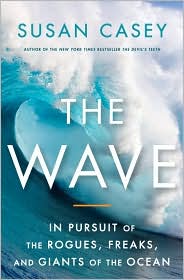
THE WAVE
In Pursuit of the Rogues, Freaks and Giants of the Ocean
From Susan Casey, bestselling author of The Devil’s Teeth, an astonishing book about colossal, ship-swallowing rogue waves and the surfers who seek them out.
For centuries, mariners have spun tales of gargantuan waves, 100-feet high or taller. Until recently scientists dismissed these stories—waves that high would seem to violate the laws of physics. But in the past few decades, as a startling number of ships vanished and new evidence has emerged, oceanographers realized something scary was brewing in the planet’s waters. They found their proof in February 2000, when a British research vessel was trapped in a vortex of impossibly mammoth waves in the North Sea—including several that approached 100 feet.
From Susan Casey, bestselling author of The Devil’s Teeth, an astonishing book about colossal, ship-swallowing rogue waves and the surfers who seek them out.
For centuries, mariners have spun tales of gargantuan waves, 100-feet high or taller. Until recently scientists dismissed these stories—waves that high would seem to violate the laws of physics. But in the past few decades, as a startling number of ships vanished and new evidence has emerged, oceanographers realized something scary was brewing in the planet’s waters. They found their proof in February 2000, when a British research vessel was trapped in a vortex of impossibly mammoth waves in the North Sea—including several that approached 100 feet.
As scientists scramble to understand this phenomenon, others view the giant waves as the ultimate challenge. These are extreme surfers who fly around the world trying to ride the ocean’s most destructive monsters. The pioneer of extreme surfing is the legendary Laird Hamilton, who, with a group of friends in Hawaii, figured out how to board suicidally large waves of 70 and 80 feet. Casey follows this unique tribe of people as they seek to conquer the holy grail of their sport, a 100foot wave.
In this mesmerizing account, the exploits of Hamilton and his fellow surfers are juxtaposed against scientists’ urgent efforts to understand the destructive powers of waves—from the tsunami that wiped out 250,000 people in the Pacific in 2004 to the 1,740-foot-wave that recently leveled part of the Alaskan coast.
Like Jon Krakauer’s Into Thin Air, The Wave brilliantly portrays human beings confronting nature at its most ferocious.
- Doubleday
- Hardcover
- September 2010
- 352 Pages
- 9780767928847
About Susan Casey
Susan Casey is the author of the New York Times bestseller The Devil’s Teeth: A True Story of Obsession and Survival Among America’s Great White Sharks. She served as creative director of Outside Magazine, where she was part of the editorial team that developed the stories behind the bestselling books Into Thin Air and The Perfect Storm, as well as the 2002 movie Blue Crush. The Toronto-born Casey was also recently named Editor-in-Chief of O, the Oprah Magazine.
Praise
“[A] captivating hybrid–an intro to the mind-melting physics of waves and a ride-along with the scientists and surfers who chase after them…Fascinating.”—Men’s Journal
“[A] breath-snatching thrill ride”—Elle
“Something is stewing in our seas, and Susan Casey—traveling, and in some cases swimming, all around the world—is eager to find out what it is. Both a rollicking look at the ocean’s growing freakishness and a troubling examination of our ailing planet, The Wave gives new meaning to the term ‘immersion reporting.'” —Hampton Sides, author of Hellhound on His Trail, Blood and Thunder, and Ghost Soldiers
“At once scary and fun, The Wave surprises at every turn.”—Elizabeth Kolbert, author of Field Notes from a Catastrophe
Discussion Questions
Why do you think there isn’t more news coverage on sunken freighters, tankers, and bulk carriers? Do tragedies at sea strike a different chord in the popular imagination than say, a plane crash?
What’s the difference between surfing a wave and surviving it? What drives people to extreme situations and how does one draw the line between determination and courting disaster?
Many big wave surfers, like Laird Hamilton, are married with children. How do you think they rationalize putting their lives on the line for what many would consider sport?
Why do you think the psychological beating is often worse than the physical for surfers? Do you think Brett Lickle’s mishap towards the end of the book helped him see what was really important in life or psychologically cripple him?
Surfers and scientists have different methods of judging a wave’s intensity. Is one rubric more accurate than the other?
Susan Casey detected a strong female presence in the scientific community that seems to be lacking in the surfing world. Why do you think surfing—and tow surfing in particular—seems to be so male-dominated? How much of it is physical and how much is psychological?
Why is respect for the waves so important? What happens if you lose this respect?
Many surfers in the book refer to themselves as “watermen.” They’re not simply athletes, or thrill seekers—they almost have a sixth sense when it comes to the water. What can we learn from these watermen in regards to how they regard and harmonize with the ocean? What responsibility, if any, do you think these adventurers have to the ocean and to each other?
Geological history has a long memory but humans have largely forgotten devastating natural disasters of the past couple of hundred years like the Lisbon tsunami of 1755. Do you think this ability to forget and move on is part of what makes our species so resilient? Or do these sorts of memory lapses leave us ill-prepared to deal with future disasters?
After Susan Casey witnesses a sixty-eight foot wave at Killers, she remembers Laird Hamilton’s assertion—“If you can look at one of these waves and you don’t believe that there’s something greater than we are, then you’ve got some serious analyzing to do…” How has your perception of the ocean—and those who study it and ride its waves—changed after reading The Wave?
